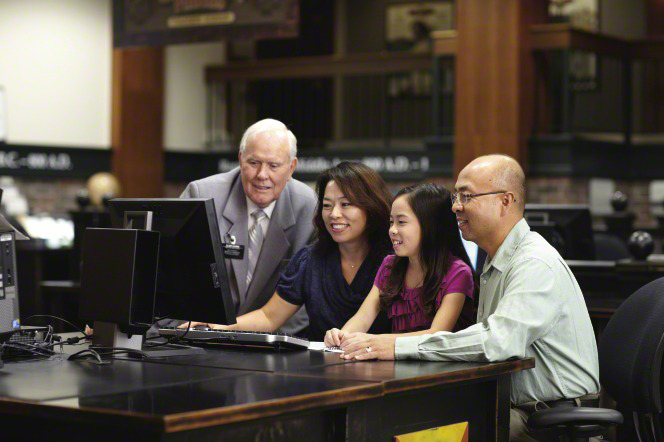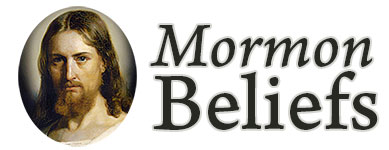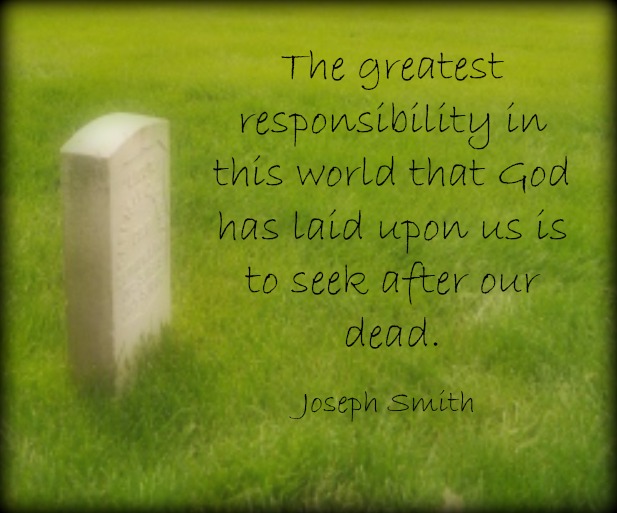As the 19th century was drawing to a close, the practice of plural marriage was also dwindling among members of The Church of Jesus Christ of Latter-day Saints. But as one stage of the Restoration of The Church of Jesus Christ was ending, another was beginning. The early Latter-day Saints knew they were laying the foundation of a great work. But they probably didn’t understand just how great the work was. The Prophet Joseph Smith said:
Brethren I have been very much edified and instructed in your testimonies here tonight, but I want to say to you before the Lord, that you know no more concerning the destinies of this Church and kingdom than a babe upon its mother’s lap. You don’t comprehend it. … It is only a little handfull of Priesthood you see here tonight, but this Church will fill North and South America—it will fill the world. … It will fill the Rocky Mountains. There will be tens of thousands of Latter-day Saints who will be gathered in the Rocky Mountains. … This people will go into the Rocky Mountains; they will there build temples to the Most High. [As quoted by Wilford Woodruff, in Conference Report, Apr. 1898, 57.]
The end of plural marriage was an important step for the future of The Church of Jesus Christ. Mormon scholar Paul H. Peterson explained:
Not only did it [the Manifesto] mark the beginning of the end of the official practice of plural marriage, but it also heralded a new age as Latter-day Saints relinquished the isolationist practices of the past and commenced a period of greater accommodation and integration into the fabric of American society.
It is important to note, however, that these changes came about through revelation—not as a result of political or other outside pressure. Regarding the Manifesto that ended plural marriage, Church President Wilford Woodruff said:
… I saw exactly what would come to pass if there was not something done. I have had this spirit upon me for a long time. But I want to say this: I should have let all the temples go out of our hands; I should have gone to prison myself, and let every other man go there, had not the God of heaven commanded me to do what I did do; and when the hour came that I was commanded to do that, it was all clear to me. I went before the Lord, and I wrote what the Lord told me to write. …
I leave this with you, for you to contemplate and consider. The Lord is at work with us. (Cache Stake Conference, Logan, Utah, Sunday, November 1, 1891. Reported in Deseret Weekly, November 14, 1891.)
The hardships of the 19th century—including the challenges of living and defending the law of plural marriage—helped to prepare the Latter-day Saints for the work ahead. The mission of the Church, to bring souls unto Christ, wasn’t changing but the scope of the work was about to expand. Elder L. Tom Perry, a member of the Quorum of the Twelve Apostles, explained:
From the very beginning prophets have been heard to encourage mankind to seek a higher kingdom, the kingdom of God. … As the Church was restored to the earth in this dispensation, the people were admonished to assist in building the kingdom of God here on earth in preparation for the return of our Lord and Savior.
Gathering the Saints to Zion
For the Latter-day Saints, building up the kingdom of God meant gathering the Saints both physically and spiritually. Of the physical gathering, William G. Hartley, of the Church Historical Department, said:
During the 19th century, “gathering” to Zion was the second step after conversion. … Converts first gathered from the United States and Canada, following Church headquarters successively from Ohio to Missouri to Illinois. … Once relocated in the far west, the Church encouraged and assisted large-scale immigration.
The gathering had two major purposes. First, Zion needed to be built up. Repeatedly persecuted and driven, the Church needed a strong, permanent base with a strong population to occupy the territory and make it economically self-sufficient. Also, the pure in heart needed a place of refuge from persecution and sin.
The Prophet Joseph Smith stated that two of the purposes for plural marriage were to “raise up seed unto” the Lord (Jacob 2:30) and to prove the Latter-day Saints “as I did Abraham, and that I might require an offering at your hand, by covenant and sacrifice” (Doctrine & Covenants 132:32, 51). The practice was successful on both counts. As a result, The Church of Jesus Christ was strengthened and fortified to the point that, by the end of the 19th century, the Church was ready to expand its bases of operation. Hartley said:
By the turn of the century the Church ceased encouraging immigration of foreign converts. Mormon settlements, it was felt, no longer could support and absorb large numbers of newcomers. Further, emigration, by sapping overseas branches of strength, hampered proselyting efforts. European Saints therefore were requested to “stay and build up the work abroad,” a policy still in effect.
This change in the gathering process had a direct effect on polygamy. Plural marriage was never encouraged outside of large concentrations of Latter-day Saints. In addition, the practice was illegal (or becoming so) in many nations. More converts were staying in their home countries, and members were also moving out of Utah to pursue other employment opportunities. Thus, the practice of plural marriage was becoming less of a viable option for the worldwide membership.
The Spiritual Gathering
The spiritual gathering occurs as Latter-day Saints make covenants with God, first at baptism and again in the holy temples of God. These covenants must be made in the right place, with the proper authority, which is the priesthood of God. Of the temple, President Boyd K. Packer said:
In the temples, members of the Church who make themselves eligible can participate in the most exalted of the redeeming ordinances that have been revealed to mankind. There, in a sacred ceremony, an individual may be washed and anointed and instructed and endowed and sealed.
The Prophet Joseph Smith taught that these temple ordinances, including covenant marriage, were essential for one to be exalted in the eternities. However, only those who make themselves eligible can participate in temple ordinances. It may be for this reason that “eternity only” plural marriages were performed. Some women whose husbands were not members or were former members may have thought that eternity only sealings— where the husband-wife relationship was for eternity only and not for this life—were the only way that they could receive these blessings. The Prophet Joseph also taught:
It is necessary … that a … welding together of dispensations … should take place … from the days of Adam even to the present time. (Doctrine & Covenants 128:18.)
“Eternity only” sealings may also have been a way to accomplish this linking of generations and families to the kingdom of God. Plural marriage also created unions for time and eternity, meaning that the couple lived as husband and wife in life as well as in the eternities. In this way, many were spiritually gathered to the kingdom of God.
This spiritual gathering of the living paved the way for the spiritual gathering of the dead—a work that continues today.
Saving Ordinances for the Dead
Saving ordinances—or those ordinances that are essential for one to be exalted—are baptism and confirmation as well as the washing, anointing, endowment and sealing in the temple. And each member of the human family must receive these ordinances for himself or herself to receive the highest blessings of eternity. However, not every person will have or has had the opportunity in this lifetime. This is where the work for the dead comes in. Elder Richard G. Scott said:
This glorious doctrine is another witness of the all-encompassing nature of the Atonement of Jesus Christ. He made salvation available to every repentant soul. His Atonement conquered death, and He permits the worthy deceased to receive all ordinances of salvation vicariously.
The doctrine of performing vicarious saving ordinances for the dead was introduced early in the Restoration of The Church of Jesus Christ. Understanding and implementation, however, evolved. As early as 10 August, 1840, the Prophet Joseph introduced doctrine of baptism for the dead in Nauvoo, Illinois. Initially, baptisms for the dead were performed in the nearby Mississippi River. But in October 1841, the Prophet Joseph said that work for the dead had to stop until it could be performed in the proper place—the holy temple. The first baptisms for the dead in the uncompleted Nauvoo Temple were performed on Sunday, 21 November 1841.
The Nauvoo Temple is also where Latter-day Saints were able to perform their own temple work. A temple is, literally, a house of God. It is a place where Latter-day Saints make covenants with God and receive sacred ordinances, including endowments and sealings. Elder Robert D. Hales explained:
Temple ordinances guide us to our Savior and give us the blessings that come to us through the Atonement of Jesus Christ. Temples are the greatest university of learning known to man, giving us knowledge and wisdom about the Creation of the world. Endowment instructions give guidance as to how we should conduct our lives here in mortality. The meaning of the word endowment is “gift.” The ordinance consists of a series of instructions on how we should live and covenants we make to live righteously by following our Savior.
Another important ordinance is being sealed for eternity in celestial marriage. This covenant of marriage allows children to be sealed to their parents and children born in the covenant to become part of an eternal family.
The first endowments and sealings for the living were performed in the Nauvoo Temple, but it would take several more decades to expand the work for the dead. Vicarious endowments for the dead began in 1877 in the temple in St. George, Utah. In 1894, Church President Wilford Woodruff again emphasized the need for natural families to be sealed together both horizontally (husband to wife) and vertically (each person to his or her own parents as well as parents to their children).
Family History—Seeking Out Our Dead
President Woodruff’s renewed emphasis on the sealing of families together lit an unquenchable fire for the Latter-day Saints. James B. Allen, at the time a professor of history at Brigham Young Unviversity, said:
The results … were impressive. Before this time relatively little genealogical work had been done among the members of the Church, and little effort had apparently been made to seal parents to children beyond one or two generations back. Now, President Woodruff told the Saints to trace their genealogies as far as they could and to perform sealings in order to “run this chain through as far as you can get it.”
A month later the Church-sponsored Genealogical Society of Utah was formed. With this stimulus a greater interest in genealogical research soon spread throughout the Church.
Elder Quentin L. Cook said:
The doctrine of the family in relation to family history and temple work is clear. The Lord in initial revelatory instructions referred to “baptism for your dead.” Our doctrinal obligation is to our own ancestors. This is because the celestial organization of heaven is based on families.
And this stimulus has not only continued but gained momentum as technological innovations have made obtaining the information increasingly more accessible. Elder Cook said:
Family history technology has also advanced dramatically. President Howard W. Hunter declared in November 1994: “We have begun using information technology to hasten the sacred work of providing ordinances for the deceased. The role of technology … has been accelerated by the Lord himself. … However, we stand only on the threshold of what we can do with these tools.”
In the 19 years since this prophetic statement, the acceleration of technology is almost unbelievable. A 36-year-old mother of young children recently exclaimed to me, “Just think—we have gone from microfilm readers in dedicated family history centers to sitting at my kitchen table with my computer doing family history after my children are finally asleep.” Brothers and sisters, family history centers are now in our homes.
This work is our obligation to our ancestors. It is not their obligation to accept it. The late Elder David B. Haight said:
We identify our ancestors so that we may perform for them the saving ordinances of the gospel in holy temples dedicated to that purpose. It is our responsibility, given to us by the Lord, to help redeem all those of our Father’s children who have lived and died without receiving the sacred ordinances of the gospel—yet all have the opportunity to accept or reject the ordinances performed in their behalf.
The late President James E. Faust said:
… Temple work is essential for both us and our kindred dead who are waiting for these saving ordinances to be done for them. It is essential because “we without them cannot be made perfect; neither can they without us be made perfect.” They need the saving ordinances, and we need to be sealed to them. For this reason it is important that we trace our family lines so that no one is left out.
Searching for our kindred dead isn’t just a hobby. It is a fundamental responsibility for all members of the Church.
Searching out our dead also allows us to learn of them, who they are and what they did. In this way, my ancestors went from being names on a page to real people who really lived. For me, it started my journey into trying to understand plural marriage and gave me greater understanding and insight into how this practice really helped to shape the Church today.
The greatest understanding came as I began researching one family line. This line consists of one childless Quaker couple, and the husband married two of my ancestors. This could not have been easy for anyone, especially since both women ended up invalids—one with a paralytic stroke and the other had a weak heart. But I have great love for this couple because they took care of my ancestors, and by their granddaughter’s account, had a happy home. Not all polygamous unions were happy, and not all of them lasted. All were difficult and required sacrifice on everyone’s part. But they passed this legacy of sacrifice and obedience to God’s commandments to their descendants.
A Natural Evolution

The modern day gathering of the Latter-day Saints includes researching our ancestors, as this family is doing at the Family History Library in Salt Lake City.
It would be a mistake to give plural marriage too much—or too little—credit in shaping The Church of Jesus Christ and its membership in the 19th century. The lessons learned helped to build a solid foundation for the Church, but the end was really a natural evolution brought on by the changing face of America and the growth of the Church.
The events surrounding the end of plural marriage paved the way for the expansion of the worldwide work of The Church of Jesus Christ. They had a solid foundation of faithful Latter-day Saints prepared to obey the commandments of God no matter what the cost. As Utah became less frontier country and more part of the United States, the Church was able to relinquish its political and economic roles and focus on its primary mission of bringing souls unto Jesus Christ. Most importantly, the repeal of plural marriage saved the temples of God from being confiscated by the U.S. government.
Rather than hindering the work of the Lord, the time had come for it to expand. The late Elder Bruce R. McConkie explained:
This gathering of Israel and this building of Zion in the last days occurs in stages. The early part of the work, which involved gathering to the United States and building stakes of Zion in North America, has already been accomplished. We are now engaged in gathering Israel within the various nations of the earth and in establishing stakes of Zion at the ends of the earth.
As the work of salvation for the living and dead continues in The Church of Jesus Christ, the issue of plural marriage will arise—especially for those whose ancestors lived it. But with proper understanding we can maintain a proper perspective of the practice and the role that it played in the history of the Church.

